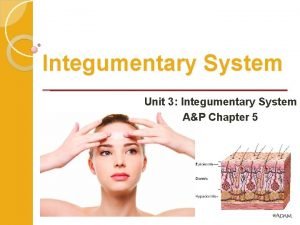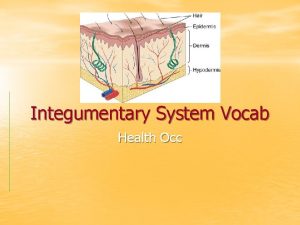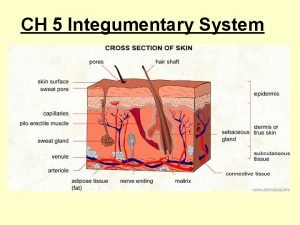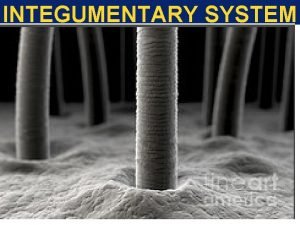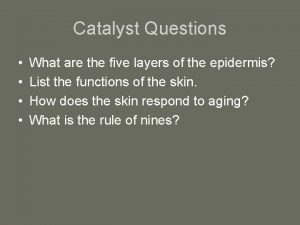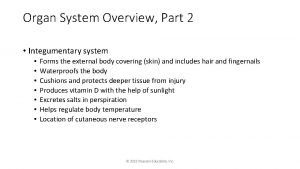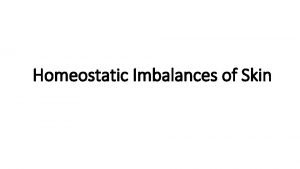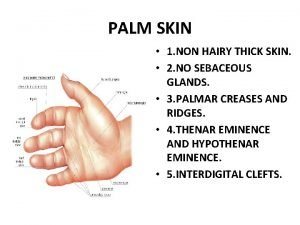Integumentary System Chapter 5 Page 65 Integumentary System































- Slides: 31

Integumentary System Chapter 5

Page 65 Integumentary System v Made up of skin & its appendages • Hair • Nails • Sebaceous glands • Sweat glands v Integumentary v 3, 000 means “covering” square inches of surface area

Page 65 Functions of the Skin v Covering v Regulate body temperature v Manufacture v Nerve Vitamin D receptors v Temporary storage of fat, glucose, water & salts v Screen out ultraviolet radiation v Special absorptive properties

Page 65 Structure of the Skin v Epidermis • • v Outermost covering Avascular Dermis • • • True skin Connective tissue Vascular

Page 66 Figure 5 - 2

Page 65 Epidermal Cells v Keratinocytes – comprise most of the epidermis & produce keratin v Merkel cells – Sensory receptors for touch v Melanocytes – Produce the pigment melanin which protects the skin against the ultraviolet rays of the sun v Langerhans cells – Macrophages that defend against microorganisms

Page 67 Epidermal Layers v Stratum germinativum – Deepest epidermal layer; undergoes continuous cell division. Papillae originate in this layer (fingerprint). v Stratum spinosum – 8 -10 cell layers thick v Stratum granulosum – Where keratinization occurs v Stratum lucidum – Palms & soles v Stratum corneum – Dead cell layer

Page 67 v Three • • • Skin Color pigments contribute to skin color: Melanin – produces two distinct classes of melanin ü Pheomelanin – which is red to yellow ü Eumelanin – which is dark brown to black Carotene – a yellow to orange pigment found in certain plants. Hemoglobin – pinkish color of some fairskinned people is due to the presence of oxygen in the hemoglobin

Pages 67 – 68 Dermis (Corium) v Thicker, inner layer of the skin below the epidermis v Composed of: • • • dense connective tissue collagen tissue bands elastic fibers muscle fibers some mast cells white blood cells • • oil & fat glands fat cells Many nerve receptors Blood vessels & heat regulation

Page 68 Subcutaneous Layer v Also v Not called hypodermal layer (Lies under dermis) a true part of the integumentary system v Attaches integumentary system to the surface muscles underneath

Page 68 Appendages - Hair v Hair is composed of Root shaft, Outer cuticle layer, the Cortex & the Inner medulla. • Root = the part of the hair that is implanted in the skin. • Shaft = projects from the skin’s surface • Hair follicle = an inpocketing of the epidermis where the hair is embedded. The shape determines the curl of the hair. v Arrector pili muscle – attached to the hair & when you get chilled your hair stands up.

Page 69 Figure 5 – 3

Page 69 Appendages - Nails v Hard structures covering the dorsal surfaces of the last phalanges of the fingers & toes v Formed in the nail bed or matrix v Lunula: white crescent at the proximal end of the nail

Page 69 Figure 5 – 4

Page 70 Appendages – Nails (Cont’d) Disease Condition & Nail Color Condition Nail Color liver disease white nails half of nail is pink; half is kidney disease white heart condition nail bed is red lung disease yellow & thickening nails Anemia pale nail bed yellowish with a slight blush diabetes at the base hypoxia bluish nails

Pages 69 – 70 Appendages – Sweat Glands v Also called sudoriferous glands v Perspiration is 99% water; it is excreted through pores v Under the control of the nervous system, these glands may be activated by several factors including heat, pain, fever, & nervousness. v 500 ml water lost per day through the skin v Ceruminous or wax glands are modified sweat glands & are found in ear canals

Page 70 Sebaceous Glands v Secretes v Sebum pliable sebum which is thick, oily substance lubricates the skin, keeping it soft &

Page 70 v Intact Microorganisms skin is the best way to protect against pathogens v Most skin bacteria are associated with hair follicles & sweat glands Handwashing v Most effective action to prevent spread of disease • 20 seconds for washing hands • 2– 4 minutes for infectious material

Page 71 SB Aging Skin v Becomes more fragile and dry v Loss of elasticity v Less effective body temperature control v Melanocytes decrease v Physiological changes can impact self-worth

Pages 70 – 71 Disorders of the Skin Acne vulgaris v Common & chronic disorder of sebaceous glands v Occurs mostly during adolescence & marked by blackheads, cysts, pimples and scarring Athlete’s foot v Contagious fungal infection v Blisters between fingers & toes causing cracking & scaling Dermatitis v Non-contagious inflammation of the skin

Page 71 Disorders of the Skin (Cont’d) Eczema v Acute or chronic, noncontagious inflammatory skin disease v Dry, red, itchy & scaly Impetigo v Acute, inflammatory, & contagious skin disease v Caused typically by staph or strep v Honey crusted exudates

Page 71 Disorders of the Skin (Cont’d) Psoriasis v Chronic inflammatory skin disease (reddish patches covered by silvery-white scales) v Autoimmune disease triggered by stress, trauma or infection Ringworm v Highly contagious fungal infection v Red, circular patches with scaly borders Urticaria (hives) v Intensely itchy, red, raised wheals or welts v Response to an allergen

Page 73 Disorders of the Skin (Cont’d) Boils (carbuncles) v Painful, bacterial infection of the hair follicles or sebaceous glands v May require an incision and drainage Rosacea v Common inflammatory disorder (chronic redness and irritation to the face) v Triggers include stress, caffeine, hot foods, and alcohol

Page 73 Disorders of the Skin (Cont’d) Herpes v Viral infection that is usually seen as a blister v Simplex includes cold sores involving the lips or beneath the nose Genital herpes v Virus that may appear as a blister in the genital area; this is covered in Chapter 21 Shingles (herpes zoster) v Skin eruption due to a viral infection of the nerve ending v Reactivation of the chicken pox virus (varicella)

Page 73 Disorders of the Hair & Nails Head lice v Parasitic v Intense insects itching & sores on the head Ingrown nails v Common nail problem Fungal infections v Infections v Makes of the nail up 50% of all nail problems

Page 73 Disorders of the Hair & Nails (Cont’d) Warts v Viral infections that affect the skin surrounding or underneath the nail v Caused by human papilloma virus (HPV)

Pages 73 – 74 v Basal Skin Cancer cell carcinoma = Most common & least malignant v Squamous cell carcinoma = Most often found on the scalp & lower lip v Malignant melanoma = Metastasizes to other areas quickly v Change in color, size, shape of a mole

Pages 74 – 76 v Rule Burns of nines – measures the percent of the body burned; the body is divided into 11 areas & each area = 9% of the body v First-degree burns = Superficial, epidermis only, no blister, redness swelling & pain v Second-degree burns = Epidermis & dermis, blister forms v Third-degree burns = Complete destruction of epidermis, dermis & subcutaneous layers forming an eschar (black skin)

Page 76 Skin Lesions v Abrasion = an injury in which superficial layers of the skin are scraped or rubbed away. v Fissure = a groove or crack like break in the skin v Laceration = a torn or jagged wound

Page 76 Pressure ulcer (decubitus ulcers) v v v Also known as Bedsores they occur along the spine, coccyx, hips, elbows & heels • Preventable & are a primary concern of health care professionals. Stage I – Redness only, skin intact Stage II – Blistered skin, broken or unbroken Stage III – Skin breaks through all layers Stage IV – Ulceration to underlying muscle & bone

Page 79 Figure 5 – 10
 Contains several layers of polygonal keratinocytes
Contains several layers of polygonal keratinocytes Unit 3 integumentary system
Unit 3 integumentary system Chapter 6 integumentary system
Chapter 6 integumentary system Do i need a title page for apa
Do i need a title page for apa Chapter 36 skeletal muscular and integumentary systems
Chapter 36 skeletal muscular and integumentary systems Glands in integumentary system
Glands in integumentary system Integumentary system vocabulary
Integumentary system vocabulary Integumentary system of pig
Integumentary system of pig Integument adalah
Integument adalah Epidermis layers
Epidermis layers Exercise 7 the integumentary system
Exercise 7 the integumentary system Integumentary vocabulary
Integumentary vocabulary Integumentary system medical terminology
Integumentary system medical terminology Integumentary system
Integumentary system Integumentary assessment
Integumentary assessment Integumentary system analogy
Integumentary system analogy The integumentary system
The integumentary system The integumentary system
The integumentary system Integumentary system components
Integumentary system components Effects of aging on the integumentary system
Effects of aging on the integumentary system Section 36-3 the integumentary system
Section 36-3 the integumentary system Integumentary system
Integumentary system Integumentary system
Integumentary system Homeostatic imbalances of skin
Homeostatic imbalances of skin Layer of tissue
Layer of tissue 6 functions of the integumentary system
6 functions of the integumentary system Skin cancer
Skin cancer Whats gametes
Whats gametes Integumentary system
Integumentary system Integumeny
Integumeny Integumentary system cpt coding guidelines ppt
Integumentary system cpt coding guidelines ppt Integumentary system of vertebrates
Integumentary system of vertebrates

